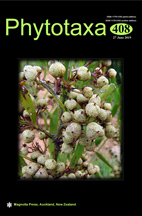Abstract
Gymnosporia sekhukhuniensis, a new species from north-eastern South Africa, is described, illustrated, mapped, and compared with closely related species. It belongs to Gymnosporia sect. Buxifoliae, more specifically Group 1, the members of which are characterized by the capsules being (2)3(4)-valved, rugose or verrucose, and the seeds partially covered by the aril. The new species has a restricted distribution range and is near-endemic to the Sekhukhuneland Centre of Endemism. This biogeographical region rich in restricted-range plants is more or less congruent with surface outcrops of mafic and ultramafic igneous rocks belonging to the Rustenburg Layered Suite of the eastern Bushveld Complex. The range of the new species shows marginal intrusion into the far northern part of the nearby Wolkberg Centre of Endemism, where it is associated with dolomites of the Malmani Subgroup. Gymnosporia sekhukhuniensis is a suffrutex mainly associated with rocky outcrops in open savannah. Diagnostic characters include its dwarf habit (up to 1.6 m tall), capsules that are relatively small (5–8 mm long), woody, scaly-rugose, with hard pointed apices, and leaves that are very laxly arranged on the stems, with some often present on the thorns. Also included is a key to the 10 currently accepted species in G. sect. Buxifoliae Group 1. The taxonomic significance of capsule and seed characters for demarcating sections and species in the genus Gymnosporia is emphasized.

